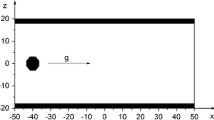Abstract
Stokesian Dynamics is a molecular-dynamics-like method for simulating the behavior of many particles suspended in a fluid. The method treats the suspended particles in a discrete sense while the continuum approximation remains valid for the surrounding fluid, i.e., the suspended particles are generally assumed to be significantly larger than the molecules of the solvent. The particles then interact through hydrodynamic forces transmitted via the continuum fluid, and when the particle Reynolds number is small, these forces are determined through the linear Stokes equations (hence the name of the method). In addition, the method can also resolve non-hydrodynamic forces, such as Brownian forces, arising from the fluctuating motion of the fluid, and interparticle or external forces. Stokesian Dynamics can thus be applied to a variety of problems, including sedimentation, diffusion and rheology, and it aims to provide the same level of understanding for multiphase paniculate systems as molecular dynamics does for statistical properties of matter.
Access this chapter
Tax calculation will be finalised at checkout
Purchases are for personal use only
Preview
Unable to display preview. Download preview PDF.
Similar content being viewed by others
References
J.F. Brady and G. Bossis, “Stokesian dynamics”, Annu. Rev. Fluid Meek, 20, 111–157, 1988.
J. Happel and H. Brenner, Low Reynolds Number Hydrodynamics, Prentice Hall, New York, 1965.
S. Kim and S.J. Karilla, Microhydrodynamics: Principles and Selected Applications, Butterworths, London, 1991.
L.J. Durlofsky, J.F Brady, and G. Bossis, “Dynamic simulations of hydrodynamically interacting particles”, Fluid Mech., 180, 21–19, 1987.
J.F. Brady, R.J. Phillips, J.C. Lester, and G. Bossis, dynamic simulation of hydrodynamically interacting suspensions”, J. Fluid Mech., 195, 257–280, 1988.
G.K. Batchelor and J.T. Green, “The hydrodynamic interaction of two small freely moving spheres in a linear flow field”, J. Fluid Mech., 56, 375–400, 1972.
A. Sierou and J.F. Brady, “Accelerated Stokesian dynamics simulations”, J. Fluid Mech, 448, 115–146, 2001.
D.L. Ermak and J.A. McCammon, “Brownian dynamics with hydrodynamic interactions”, J. Chem. Phys., 69, 1352–1360, 1978.
W.B. Russel, D.A. Saville, and W.R. Schowalter, Colloidal Dispersions, Cambridge University Press, Cambridge, 1989.
A.J. Banchio and J.F. Brady, “Accelerated Stokesian dynamics: Brownian motion, ” J. Chem. Phys., 118, 10323–10332, 2003.
R.J. Phillips, J.F. Brady, and G. Bossis, “Hydrodynamic transport properties of hard-sphere dispersions. I. Suspensions of freely mobile particles”, Phys. Fluids, 31, 3462–3472, 1988.
A.J.C. Ladd, “Hydrodynamic transport coefficients of random dispersions of hard spheres”, J. Chem. Phys., 93, 3484–3494, 1990.
J.R. Melrose and R.C. Ball, “The pathological behavior of sheared hard-spheres with hydrodynamic interactions”, Europhys. Lett., 32, 535–546, 1995.
D.I. Dratler and W.R. Schowalter, “Dynamic simulation of suspensions of non-Brownian hard spheres”, J. Fluid Mech., 325, 53–77, 1996.
J.F. Brady and J.F. Morris, “Microstructure of strongly sheared suspensions and its impact on rheology and diffusion”, J. Fluid Mech., 348, 103–139, 1997.
J.F. Brady, “The rheological behavior of concentrated colloidal dispersions, ” J. Chem. Phys., 99, 567–581, 1993.
D.R. Foss and J.R. Brady, “Structure, diffusion and rheology of Brownian suspensions by Stokesian dynamics simulations”, J. Fluid Mech., 407, 167–200, 2000.
P.R. Nott and J.F. Brady, “Pressure driven flow of suspensions: simulation and theory”, J. Fluid Mech., 275, 157–199, 1994.
Author information
Authors and Affiliations
Editor information
Editors and Affiliations
Rights and permissions
Copyright information
© 2005 Springer
About this chapter
Cite this chapter
Sierou, A. (2005). Stokesian Dynamics Simulations for Particle Laden Flows. In: Yip, S. (eds) Handbook of Materials Modeling. Springer, Dordrecht. https://doi.org/10.1007/978-1-4020-3286-8_139
Download citation
DOI: https://doi.org/10.1007/978-1-4020-3286-8_139
Publisher Name: Springer, Dordrecht
Print ISBN: 978-1-4020-3287-5
Online ISBN: 978-1-4020-3286-8
eBook Packages: Physics and AstronomyPhysics and Astronomy (R0)




